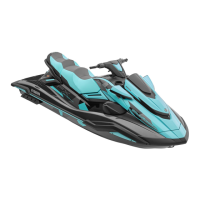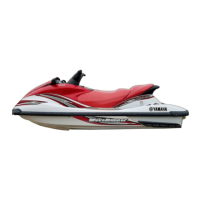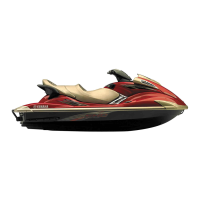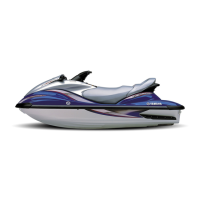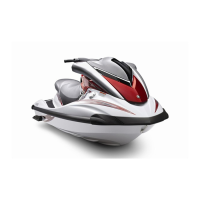
Do you have a question about the Yamaha WaveRunner FZR SVHO 2016 and is the answer not in the manual?
| Displacement | 1, 812 cc |
|---|---|
| Horsepower | 250 hp |
| Hull Material | NanoXcel 2 |
| Fuel Type | Unleaded gasoline |
| Fuel Capacity | 18.5 gal |
| Seating Capacity | 3 persons |
| Rider Capacity | 3 persons |
| Pump Type | 155 mm |
| Engine Type | Supercharged 4-stroke, 4-cylinder, DOHC |
| Length | 132.7 in |
| Width | 48.4 in |
| Height | 45.3 in |
Records identification numbers for parts and theft prevention.
Details various labels found on the watercraft for user information.
Highlights critical safety warnings displayed on the watercraft.
Describes additional labels providing specific information or certifications.
Specifies age, experience, and passenger limits for safe operation.
Outlines conditions and maneuvers to avoid for safe watercraft operation.
Details essential gear and conditions for safe watercraft operation.
Lists items recommended to be carried on board for safety and emergencies.
Warns about dangers such as exhaust fumes and hot engine parts.
Explains how the watercraft handles, including jet thrust and steering.
Advises on legal and responsible operation according to waterway regulations.
Encourages respectful and environmentally conscious use of the watercraft.
Defines key terms and speeds related to watercraft operation.
Identifies and illustrates exterior and interior parts of the watercraft.
Details the components located within the engine compartment.
Explains the operation of various controls and systems.
Describes the function and handling of the remote control transmitter.
Details how the security system prevents unauthorized use or theft.
Explains the function of the red engine stop switch.
Describes the operation of the engine shut-off switch and lanyard.
Explains how to use the green start switch.
Details how the throttle lever controls engine speed.
Explains how to steer the watercraft using the handlebars.
Describes how to adjust the handlebar position for comfort.
Explains the function of outlets that show cooling water discharge.
Describes the water separator and how to drain it.
Covers core operational aspects like reverse and trim systems.
Explains how to engage and use the reverse function.
Details how to adjust the trim angle for optimal performance.
Explains different operating modes available for the watercraft.
Describes the Low RPM Mode for reduced engine speed operation.
Explains the main instrument cluster and its indicators.
Details the speedometer function and units of measurement.
Explains the tachometer's role in showing engine speed.
Describes the digital display for various operating conditions.
Explains the dual function meter for hours run and battery voltage.
Shows how to read the fuel level indicator.
Alerts the user to low fuel conditions.
Indicates low oil pressure conditions.
Warns about high engine temperatures.
Alerts to potential engine malfunctions or sensor issues.
Details how to remove and install the front and rear seats.
Explains the use of the grip for reboarding from water.
Describes the function and proper use of the reboarding step.
Explains the purpose of the bow eye for securing the craft.
Explains the purpose of the stern eyes for securing the craft.
Information on the watercraft's storage areas and their capacity.
Details the bow compartment, its capacity, and how to drain it.
Describes the glove compartment, its capacity, and how to drain it.
Explains the location and removability of the beverage holder.
Details the removable storage compartment's capacity and security.
Explains the location and use of the fire extinguisher holder.
Specifies the correct type and octane rating of gasoline required.
Information on using gasohol blends, including ethanol and methanol content.
Step-by-step instructions for refueling the watercraft safely.
Details the recommended engine oil type, viscosity, and grade.
Provides instructions on how to check the engine oil level.
Explains procedures for draining bilge water on land and on water.
Guidelines for securely transporting the watercraft on a trailer.
Instructions for the essential engine break-in procedure for new watercraft.
An overview checklist of all checks before operating the watercraft.
Detailed checks to perform while the watercraft is on land.
Inspects the engine compartment for damage and ventilation.
Verifies the fuel system for leaks and proper condition.
Ensures adequate fuel is present in the tank.
Confirms no water has collected in the water separator.
Inspects the exterior of the engine unit for issues.
Verifies the engine oil level is within the correct range.
Ensures the engine compartment is free of bilge water.
Verifies battery connections, leads, and breather hose.
Confirms smooth and unrestricted steering operation.
Ensures the telescopic steering adjusts and locks properly.
Verifies the Q.S.T.S. selector operation and locking.
Confirms the reverse system operates smoothly and correctly.
Ensures the throttle lever operates smoothly and returns properly.
Verifies the proper operation of the remote control transmitter.
Inspects the engine shut-off cord for damage or defects.
Checks the operation of start, stop, and shut-off switches.
Verifies storage compartments are intact and dry.
Inspects the fire extinguisher holder and related parts for damage.
Confirms a full fire extinguisher is on board.
Ensures required safety equipment is present.
Inspects the hull and deck for damage or problems.
Verifies the jet intake is clear and undamaged.
Checks the jet thrust nozzle and reverse gate for damage.
Inspects stern drain plugs and O-rings for damage and proper installation.
Ensures the hood is securely closed.
Checks to perform after launching the watercraft.
Verifies water discharge from cooling water outlets.
Confirms the proper operation of the instrument cluster.
Measures engine idling speed against the specified range.
General guidelines for operating the watercraft safely.
Introduces basic techniques and familiarization with the craft.
Emphasizes pre-operation checks and safe operating practices.
Details the correct posture for operator and passenger.
Provides instructions for safely launching the watercraft.
Step-by-step guide to starting the engine while in the water.
Explains how to safely stop the engine.
Procedures for securing the watercraft when leaving it.
Basic forward operation and handling of the watercraft.
Techniques for making turns at various speeds.
How to bring the watercraft to a stop, noting it has no brakes.
Instructions for using the reverse function.
Procedures for boarding the watercraft from the water.
Step-by-step guide for boarding the watercraft solo.
How to board the watercraft with an additional passenger.
Guidance on how to begin moving after starting the engine.
Procedures for starting and moving off after trailer launch.
Steps for boarding and starting from a dock.
Instructions for righting a capsized watercraft.
Procedures for bringing the watercraft to a beach or dock.
Advice for operating in areas with heavy weed growth.
Steps to take after taking the watercraft out of the water.
Essential steps after using the watercraft.
Procedure to prevent clogging of cooling passages.
Procedures for storing the watercraft for extended periods.
Details lubrication points and methods for smooth operation.
Steps to protect metallic parts from corrosion.
Instructions for washing, waxing, and protecting the watercraft.
Guidelines for maintaining the watercraft's battery.
Information about the included tool kit and its storage.
Steps to access the engine by removing the cover.
Schedule for regular checks and servicing by owner or dealer.
Details on changing engine oil and oil filter.
General guide to diagnosing and resolving common watercraft issues.
A table listing common problems, causes, remedies, and page references.
Critical steps to take in specific emergency situations.
Instructions for clearing obstructions from the jet intake.
Procedure for starting the watercraft using a booster battery.
Steps for safely connecting jumper cables to the battery.
Guide on how to identify and replace blown fuses.
Instructions for safely towing a disabled watercraft.
Steps to take if the watercraft becomes submerged.




